Valerie C. Coffey, Freelance Science Writer
From the first laser fired on another planet to observatory guide stars and space collision avoidance systems, lasers in space are making news with numerous advances and universal firsts (as far as we know).
With the beginning of the Laser Lunar Ranging experiment in the 1960s, the use of lasers in space moved out of the realm of science fiction into reality. While lasers-as-lightsabers are still only Star Wars fiction, the numerous ways we use lasers in space applications are pretty cool, even to non-nerdy folks.
NASA’s Mars rover Curiosity has been front and center in the news since its landing on the distant big red rock on Aug. 6 of this year.1 Part of its mission is to search for markers of biological habitability as well as to study geology, climate and the role of water on the planet. In a functional “target practice” test on Aug. 19, Curiosity’s powerful megawatt laser became our first to be fired on another planet (see Figure 1). In that first self-test of the instrument after landing, it fired 30 5-ns-long pulses, each with more than 1 million W of power, over a 10-s period at a fist-size rock dubbed “Coronation.”
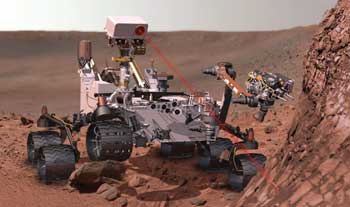
Figure 1. NASA’s Mars Curiosity rover uses its mast-mounted, megawatt infrared laser (an invisible ray illustrated here in visible red light) to vaporize a bit of rock. The resulting light is captured by a telescope and a camera, routed via fiber optics to three spectrographs in the instrument, and analyzed to identify its components.
A powerful mast-mounted infrared diode laser, supplied by France-based 3S Photonics, is part of the nuclear-powered rover’s Chemistry and Camera instrument, or ChemCam. The laser, which uses a Nd:KGW crystal to produce 1.067-µm light, works by heating up a hole in the rock 2 to 4 mm wide from up to 9 m away until its atoms are vaporized to form an ionized, glowing plasma.2 Then ChemCam’s 4.3-in.-aperture telescope detects the light and directs it through an optical fiber to three spectrographs within the rover.
The spectrographs divide the spectrum from the glow and record the resulting wavelengths from ultraviolet to infrared, which scientists can use to identify the precise elemental composition of Coronation and the other targets it zaps (see Figure 2). Use of this laser-induced breakdown spectroscopy technique isn’t new, but the laser involved here (although pulsed) is in the same class as the powerful Boeing YAL-1 Airborne Laser weapons system designed by the US Department of Defense’s Missile Defense Agency to destroy ballistic missiles and other threats from an airborne platform.
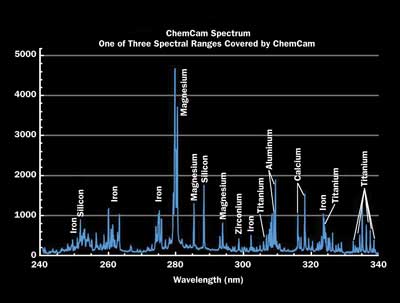
Figure 2. The ChemCam instrument has three spectrographs to analyze the laser-vaporized rock emission. The shortest-wavelength spectrograph starts in the UV at 240 nm and can detect emission peaks of iron, magnesium, silicon, zirconium and several other elements. ChemCam was designed and built by a US-French team led by Los Alamos (N.M.) National Laboratory; NASA’s Jet Propulsion Laboratory in Pasadena, Calif.; the Centre National d’Études Spatiales (the French Space Agency); and the Centre d’Étude Spatiale des Rayonnements at the Observatoire Midi-Pyrénées in Toulouse, France.
Although for decades lasers were a key focus in a variety of space-based defense R&D programs, the US Air Force’s Airborne Laser program ended in 2011, deemed unworkable and too expensive. Likewise, the Missile Defense Agency currently has no active programs or plans to deploy directed energy weapons in space, according to Richard Lehner, spokesman for the agency.
“Besides being less cost-effective than land- and sea-based missile defense technologies,” Lehner said, “there is no threat that currently justifies the development and testing of lasers in space for defensive purposes. The development and test effort would be extensive, cost several billion dollars and have no guarantee of success.”
Laser guide stars
The US military isn’t developing Star Wars-style laser-defense systems in space, but one branch of the military is indeed shining lasers into space. Part of the mission of the Air Force Research Laboratory’s Directed Energy Directorate is to develop real-time tracking, imaging and identification of space objects. To accomplish this, the AFRL leads in the development of cutting-edge laser-guide-star adaptive optics capable of tracking objects in space.
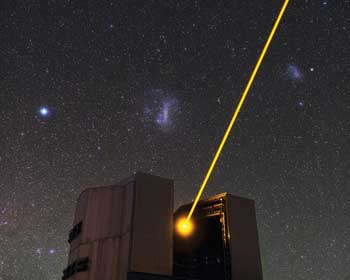
Figure 3. Yepun observatory, the fourth 8.2-m Unit Telescope of ESO’s Very Large Telescope (VLT) facility, launches a sodium-band laser guide star into the sky in June 2012 as part of its adaptive optics system, to be upgraded in 2013. The Large and Small Magellanic Clouds glow in the night sky.
Adaptive optics technology helps overcome the atmospheric turbulence that distorts ground-based telescope images by using a laser, typically a narrowband sodium laser with a few watts of power, projected on the mesosphere to create an artificial “star” (see Figure 3). Atmospheric conditions cause this guide star to waver and twinkle in the same manner as target objects near it. Tracking of the twinkling guide star enables a deformable telescope mirror with actuators to instantaneously correct wavefront distortions hundreds of times per second. The sodium wavelengths of the laser easily can be filtered out of observations.
In June 2012, The Boeing Co. in Chicago announced completion of a two-year modernization to the Maui Space Surveillance System at the Air Force Maui Optical and Supercomputing Site on Mount Haleakala in Hawaii.3 The site houses a 3.67-m-diameter adaptive-optics telescope called the Advanced Electro-Optical System (AEOS), which can track near-Earth and deep-space objects (see Figure 4). The telescope sits in a retractable cylindrical enclosure that enables open-air operation at an elevation of 10,000 ft.
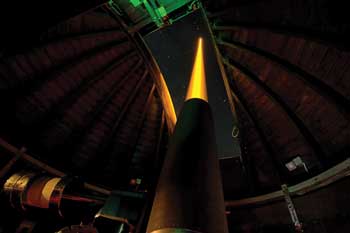
Figure 4. The Air Force Research Laboratory’s 3.6-m, 75-ton Advanced Electro-Optical System (AEOS) telescope is located at the Directed Energy Directorate’s Air Force Maui Optical and Surveillance Site on Mount Haleakala in Hawaii. The green laser illumination of the telescope is a reflection from laser propagation experiments between Mauna Loa on the island of Hawaii and Mount Haleakala on Maui.
At the heart of the AEOS telescope is a deformable mirror with 941 actuators that change the mirror’s shape to remove atmospheric distortion. The upgrade of sensors, software and computer systems brought AEOS to full operational capability with the ability to image and track objects in orbit.
In July, MPB Communications of Montreal and photonics manufacturer Toptica of Munich unveiled a novel adaptive optics system at the SPIE Astronomical Telescopes + Instrumentation conference in Amsterdam.4 The SodiumStar 20/2 laser system was developed to withstand the harsh environmental conditions at the European Southern Observatory (ESO) in Cerro Paranal, Chile. The system is based on narrowband Raman fiber amplifier technology pioneered by ESO, which works by amplifying the tunable diode laser at 1178 nm to 35 W of optical power. Frequency conversion to the sodium resonance at 589 nm results in more than 20 W of output power with a linewidth of approximately 5 MHz.
The SodiumStar 20/2 technology is portable and can be installed directly on the telescope because the bulky pumping unit can be separated up to 30 m from the laser head (see Figure 6). Four SodiumStar 20/2 lasers are scheduled for installation in 2013 as part of the adaptive optics system on each of the four unit telescopes of the ESO’s Very Large Telescope (VLT) group.
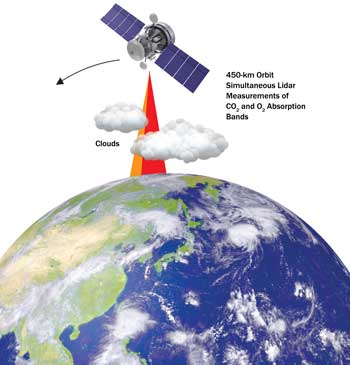
Figure 5. The NASA ASCENDS mission would use lasers on space-based platforms to measure CO2 and O2 absorption in the Earth’s atmosphere. The light-detection-and-ranging-based approach will enable observations day and night.
Lasers on R&D satellites
Although laser-guide-star adaptive optics technology has been in use for nearly two decades, lasers are involved in several novel space research proposals, too. A NASA proposal to study carbon dioxide in the Earth’s atmosphere will use a new laser-based system, the CO2 Sounder, to globally measure CO2 from space.5 The Active Sensing of CO2 Emissions of Nights, Days, and Seasons (ASCENDS) mission, currently due to be launched in 2022, proposes monitoring the amount of atmospheric carbon dioxide that trees and foliage are absorbing and emitting in the processes of photosynthesis and respiration. Lasers mounted on a low-Earth-orbit satellite would bounce light through the atmosphere, off Earth and back through the atmosphere to a telescope/detector, to measure one of two CO2 absorption bands at 2 µm and 1.6 µm, and a third band from molecular oxygen at 0.78 µm (see Figure 5).
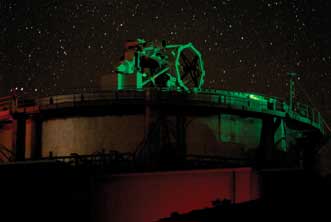
Figure 6. A 20-W portable guide-star laser prototype designed for ESO’s VLT facility sees first light during field tests June 21, 2011, at the Allgäu Public Observatory in Ottobeuren, Germany.
This method would improve upon current satellite-based concepts that use sunlight as a source and, thus, are limited to measuring in daylight. A smaller footprint on the surface means that the observational path will not be affected by cloud contamination, which inhibits observations at the surface where CO2 exchange and mixing processes occur. Because the project is still in the very early stages of planning and budgeting, said Ken Jucks, program scientist for ASCENDS, the type of lasers to be used is still under consideration but may include continuous-wave, pulsed or fiber-amplified ones of a few watts of power.
In another novel use of lasers in space, James Mason and colleagues at NASA Ames Research Center in Palo Alto, Calif., have proposed lasers as a way to clear the plethora of space debris in orbit around the Earth.6 Earth-based lasers with 5 to 10 kW of power could collectively provide just enough photons to slightly nudge an object in low-Earth orbit away from a collision course with a satellite, or nudge it toward de-orbit and cause it to burn up upon re-entry into the atmosphere. Such a laser would not have enough intensity to accidentally damage a satellite or to raise concern from other space-faring nations and could be marketed as a commercial venture that could be shared by many countries, the researchers say.
Space-based communications
The conventional radio-frequency communications used in space can’t keep up with the demand for moving vast quantities of data generated by increasing numbers of sensors, telescopes and sophisticated command-and-control missions. This data is transmitted around the Earth and the solar system using existing ground-to-satellite infrastructure, which is outdated and slow.
To address this problem, researchers at NASA’s Goddard Space Flight Center and Jet Propulsion Laboratory (JPL), and at MIT Lincoln Laboratory are working on the Laser Communications Relay Demonstration (LCRD or LaserCom), a long-duration NASA optical communication mission. It will use lasers to encode and transmit data at rates 10 to 100 times faster than NASA’s current communications capabilities.7
“The space station and Hubble Space Telescope had continuous video sent to Earth that only worked from low-Earth orbit to geosynchronous orbit,” said David Israel, principal investigator for LaserCom. “This system will have relays demonstrating how we can take advantage of optical links. The project is analogous to network service providers on Earth upgrading to fiber in telecom.”
The demonstration tests, scheduled for 2017, will involve two-way data transmission from ground stations in White Sands, N.M., and JPL to satellites in orbit. In the ensuing years, NASA hopes that its demonstration system will be replaced by more advanced hardware in orbit.
[email protected]
References
1. Mars Rover’s Laser Zaps First Target, Photonics.com (Aug. 22, 2012): https://www.photonics.com/Article.aspx?AID=51678.
2. http://www.msl-chemcam.com.
3. http://www.boeing.com/bds/news/ (Jun. 20, 2012).
4. http://www.toptica.com/fileadmin/user_upload/Brochures/toptica_BR_SodiumStar20-2.pdf.
5. NASA: Space Laser to measure CO2 on Earth (video): http://www.youtube.com/watch?v=1_p2ae7RoM4 (Aug. 31, 2012)
6. J. Mason et al, Orbital Debris-Debris Collision Avoidance (Jul. 19, 2012), Advances in Space Research: http://arxiv.org/pdf/1103.1690.pdf.
7. http://esc.gsfc.nasa.gov/267/LCRD.html.